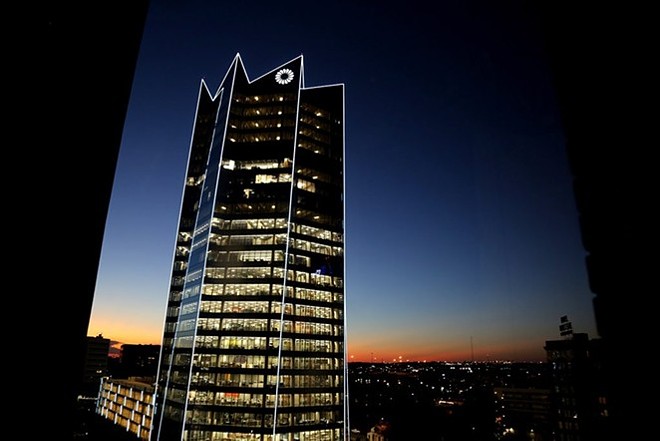
Editor's Note: CityScrapes is a column of opinion and analysis.
In San Antonio, it's always about land.
According to recent news reports, Weston Urban — the development entity of Rackspace co-founder Graham Weston — is working to develop a new minor league ballpark downtown. The location? Conveniently near Weston's other holdings and development projects, including the Weston Centre, the Milam Building, the Rand Building and the new Frost Tower on the west side of downtown, near San Pedro Creek.
The ballpark plan is reported to involve a site near San Pedro Creek, just north of Martin Street and west of Flores Street.
City and county leaders have long floated the idea of a downtown ballpark, presumably used by the San Antonio Missions or an upgraded minor league team. Any number of other cities have embraced similar ballpark-as-revitalization anchor strategies. And almost invariably, those involved significant public financing. In other words, the local government often picks up the full development cost.
The reports of Weston's efforts don't make clear how a new ballpark might be funded. But the logic for Weston and Weston Urban is crystal clear. Built near the existing Weston Centre tower, Frost Tower and the sites of Weston Urban's planned new downtown housing initiatives, the sports facility would boost economic activity and land values in a part of downtown substantially owned and controlled by Weston.
That phenomenon of looking to major public investment to boost private gain has a long and storied history in San Antonio and its fundamentally divided downtown core.
Almost 150 years ago, San Antonio's business leaders and major property owners faced a serious problem. The growing city, newly accessible via the railroad, was still a Wild West frontier town.
Its reputation wasn't helped by national newspaper headlines about the "Fatal Corner"— shootouts at the Vaudeville Theatre right on Main Plaza in 1882 and 1884 that left three dead and another mortally wounded.
Then there was the White Elephant Saloon down the block from the Vaudeville, the scene of a January 1885 "gambling quarrel" that left young Charles Brice shot in the head by Sam Parks, who initially fired shots at someone else altogether. Just a few months earlier, another disagreement between gamblers at the White Elephant led to drawn pistols but no fired shots.
The violence, gambling and prostitution in the heart of San Antonio posed a real problem for downtown business and property owners. So-called "adult amusements" brought ranchers, cowboys and soldiers to the center. But they also brought mayhem and bad publicity.
One response came in December 1889, with the passage of a city ordinance to "suppress and restrain bawdy houses" together with a companion ordinance restricting gaming establishments. While the 1889 ordinances didn't specify where the "restrained" houses might operate, the city licensing process effectively moved them all from Main Plaza and the city's heart to "west of the creek" — San Pedro Creek to be exact.
Two years prior, San Antonio voters approved a bond issue to construct a new city building to replace the "filthy" and "unhealthy" combined city hall-jail dubbed the "Bat Cave." But Mayor Bryan Callaghan Jr. and the council had been careful not to specify a site, for the obvious reason that the competing interests and "sides" of downtown were each seeking the benefit of a grand new civic building.
Merchants around Alamo Plaza saw the new city hall as their due and a potential boost to their bottom lines. As the San Antonio Light newspaper put it in June 1887, "The east and west side[s] of the river, both want it, and it remains to be seen which will give the larger bonus."
The bonus of course would be a private contribution toward the cost of the new building, an early form of "public-private partnership." Mrs. M. A. Maverick offered land adjacent to Travis Park with the promise of an additional $2,500 for the city. And on the west side of the river, Col. T. C. Frost and Thad. W. Smith promoted either Main Plaza or Military Plaza, for which the two businessmen would donate $6,000 in cash to the city.
Frost's interest in the Main or Military Plaza locations was clear. He had joined his brother in a business on Main Plaza just after the Civil War, and by the mid-1880s, he owned a thriving wool commission and banking business steps north of the cathedral on the plaza.
Keeping the city hall and city business west of the river would clearly support Frost's business and property interests.
Frost obviously won the fight. City Hall remains neatly placed in Military Plaza. That choice bolstered the area west of the river as the focus of the city's banking and financial firms, much as it remains today.
What's the lesson for us?
Graham Weston's interests may well not be the best interests of the city and its citizens, or even the best way to boost downtown.
If we are to have a downtown ballpark, what we need at least is a serious professional planning effort coupled with a broad community-wide discussion of whether a ballpark is truly a public priority and where it should go.
The days of narrow, effectively unilateral decision making, like the siting of the Alamodome and AT&T Center, should be well behind us. By now, it should be evident that those calls were not about the promise of sports, the enjoyment of the game or "development."
Here it's always about land — and someone's profit.
Heywood Sanders is a professor of public policy at the University of Texas at San Antonio.
Stay on top of San Antonio news and views. Sign up for our Weekly Headlines Newsletter.

